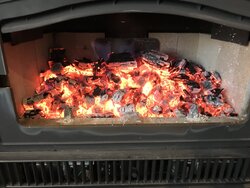
Evening everyone!
So far, happy to be a member of this thread. I read the whole thing, learned some interesting fixes to a poor install, that I luckily have not had to pay for to date. That’s another story though. I’ll tell you this stove love to be started with a top down fire, needs to be kept hot +250 and easily leaves me hot coals after 8 hours of sleep, without much problem, and my woods still a little green. Can’t wait to see what this thing does with real dry wood.
I do have a few questions:
Lower block off plate? When I pull my stove out and install it, will this reduce or stop the drafting issue I just found at the sides of my surround shroud? I believe it will.
Also, my insert is inside what was left of an old heatilator metal fireplace box. I cut out the inside walls in the entirtry, and the flue plate leaving only the exterior wall of the heatilator, inside the masonry fireplace. The cinderblock fireplace/ chimney walls are 8” thick block with a stucco scratch coat and veneered with real stone anywhere’s from 1 1/2” to 3” thick. Any reason I should be concerned with over heating the old metal from the heatilator? I think not, should dissipate through the block or be sent back into the air gap between new and old and thus be used up by the blower fans.
Finally, how many people have had over firing issues after installing a lower block off plate? Seems like if it does what it is suppose to, it would be easy to overfire. I suspect the further up the chimney you can block off the less chance of over firing as there will be a larger air gap there.
Does anyone know if the latch is adjustable? Someone asked previously, but I don’t think this was answered. My brand new stove is failing the dollar bill test on the latch side.
This thread was awesome, thanks for starting it, and keeping it going. You flattened my learning curve!



![IMG_E8163[1].JPG IMG_E8163[1].JPG](https://www.hearth.com/talk/data/attachments/215/215900-d5c6aa269f8a9cb493e57e14203868ee.jpg)